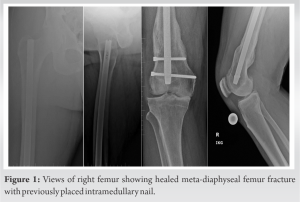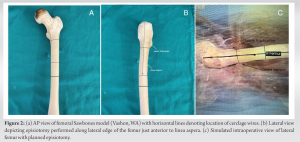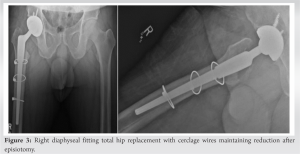Incarcerated femoral nails can pose a significant challenge for orthopedic surgeons, but one effective technique for removal is a proximal femur episiotomy.
Davison Beenfeldt, University of Nevada, Reno School of Medicine, 3050 Accacia Way, Reno, 89503 Nevada. E-mail: davisonb@med.unr.edu
Introduction: Incarceration of intramedullary nails can pose a significant challenge. There are many reported techniques of nail removal, but when these fail, it can be difficult to determine how to proceed. Here, it is shown that a proximal femoral episiotomy can be used with great effect.
Case Report: 64-year-old male developed hip arthritis. The patient had a solid antegrade femoral nail placed 22 years ago that required removal for a hip arthroplasty. A proximal femoral episiotomy-assisted approach was used with good results and patient outcome.
Conclusion: There are several well described techniques to assist with incarcerated nail removal that all trauma surgeons should be familiar with. Proximal femoral episiotomy is a useful technique, every surgeon should have in their arsenal.
Keywords: Hardware removal, episiotomy, incarcerated femoral nail, hip arthroplasty.
Intramedullary nailing has been the treatment of choice for femoral shaft fractures in adults for years. Implant removal has become more common due to the need for conversion to arthroplasty or the fixation of periprosthetic fractures. Incarcerated intramedullary femoral nails often present a significant challenge for surgeons during implant removal. Nail incarceration can require non-traditional methods for extraction and many different techniques have been described [1, 2, 3]. However, often multiple extraction techniques are required each carrying a risk for iatrogenic injury. In cases where injury does occur, there is limited information on how best to proceed. One effective method for removal of incarcerated femoral nails is a proximal femur episiotomy. We present a case report and description of this technique.
A 64-year-old male with a medical history of hypertension, hyperlipidemia, and pulmonary embolism developed hip arthritis. The patient had a solid antegrade femoral nail placed 22 years ago and had a well healed femoral shaft fracture with good cortical bone (Fig. 1).  His arthroplasty surgeon requested hardware removal by the orthopedic trauma service before hip replacement. After thorough pre-operative discussion of risks and benefits of hardware removal, surgical consent was obtained and standardized “time out” was performed. Pre-operative antibiotics were administered and the patient was placed in the lateral decubitus position on a radiolucent table. The hip and lower extremity were prepped and draped. The previous 3 cm lateral proximal incision was utilized to gain access to the proximal femur, splitting the gluteus in line with its fibers. The nail was carefully exposed and cleared of debris with currettes. A conical extraction bolt was inserted into the proximal aspect of the nail with good interference fit. Once the extraction jig was attached proximally, the two distal interlock screws were removed through previous percutaneous incisions. The nail was then backslapped using the extraction jig approximately 3 cm at which point the nail unfortunately became incarcerated. Continued attempts at extraction ultimately resulted in iatrogenic basicervical femoral neck fracture. At this point, the decision was made to perform a proximal femoral episiotomy to relieve hoop stresses allowing for nail removal. To do so, the remainder of the femur was exposed distally using an extensile lateral subvastus approach (Fig. 2c). A prophylactic cable was placed distally to prevent fracture propagation. Next, a microsagittal saw was used to make a single linear longitudinal osteotomy down the femur just anterior to the linea aspera (Fig. 2a and b).
His arthroplasty surgeon requested hardware removal by the orthopedic trauma service before hip replacement. After thorough pre-operative discussion of risks and benefits of hardware removal, surgical consent was obtained and standardized “time out” was performed. Pre-operative antibiotics were administered and the patient was placed in the lateral decubitus position on a radiolucent table. The hip and lower extremity were prepped and draped. The previous 3 cm lateral proximal incision was utilized to gain access to the proximal femur, splitting the gluteus in line with its fibers. The nail was carefully exposed and cleared of debris with currettes. A conical extraction bolt was inserted into the proximal aspect of the nail with good interference fit. Once the extraction jig was attached proximally, the two distal interlock screws were removed through previous percutaneous incisions. The nail was then backslapped using the extraction jig approximately 3 cm at which point the nail unfortunately became incarcerated. Continued attempts at extraction ultimately resulted in iatrogenic basicervical femoral neck fracture. At this point, the decision was made to perform a proximal femoral episiotomy to relieve hoop stresses allowing for nail removal. To do so, the remainder of the femur was exposed distally using an extensile lateral subvastus approach (Fig. 2c). A prophylactic cable was placed distally to prevent fracture propagation. Next, a microsagittal saw was used to make a single linear longitudinal osteotomy down the femur just anterior to the linea aspera (Fig. 2a and b). An osteotome was utilized to expand the bone slightly which released the hoop stress on the nail allowing for successful nail removal. An acute diaphyseal fitting total hip arthroplasty was then performed by the arthroplasty surgeon. After surgery, the patient was made weightbearing as tolerated following our normal total hip arthroplasty post-operative protocol. He was mobilized by physical therapy on post-operative day 1 and was full weightbearing on the operative extremity. He was discharged home on postoperative day 2. Repeat radiographs demonstrated episiotomy healing and a well-fixed total hip arthroplasty at 3 months (Fig. 3). At 1 year, he was doing well and currently seeks ipsilateral total knee arthroplasty.
An osteotome was utilized to expand the bone slightly which released the hoop stress on the nail allowing for successful nail removal. An acute diaphyseal fitting total hip arthroplasty was then performed by the arthroplasty surgeon. After surgery, the patient was made weightbearing as tolerated following our normal total hip arthroplasty post-operative protocol. He was mobilized by physical therapy on post-operative day 1 and was full weightbearing on the operative extremity. He was discharged home on postoperative day 2. Repeat radiographs demonstrated episiotomy healing and a well-fixed total hip arthroplasty at 3 months (Fig. 3). At 1 year, he was doing well and currently seeks ipsilateral total knee arthroplasty.
Intramedullary nail removal is becoming more common, with indications including infection, hardware irritation, pain, non-union, and planned arthroplasty procedures. Over the past 10 years, increasing numbers of total joint arthroplasties are being performed which has also been associated with higher rates of femoral nail removal [4]. Longitudinal episiotomy osteotomy [5], greater trochanter osteotomy [6], and formation of a femoral window [7] have been shown to be effective in loosening the nail for extraction. Common surgical instruments have also proven useful in nail removal including insertion of a Steinmann nail into bone [8] or the tip of a cannulated screw [9], use of an Ender’s nail [10], or use of a cancellous Schanz screw [11]. Incarcerated intramedullary nails pose a different technical challenge and obvious risk of iatrogenic injury during removal. Unfortunately, there is limited evidence on how to proceed in this setting. Several published reports describe methods for removal of an incarcerated femoral nail in the setting of planned total hip arthroplasty [6, 12, 13, 14]. In many of these cases, removal of the femoral head in preparation for total hip arthroplasty assists in removal of the nail due to increased exposure of the proximal segment of the nail. This is not limited to nails exclusively as there are also reports of incarcerated screw removal using a similar approach [15]. Other techniques for removal of an incarcerated nail include utilization of a distal approach in which retrograde mobilization of the nail is achieved through tapping of the nail from an infrapatellar position [1]. There is also a risk of iatrogenic injury utilizing this approach [13]. The purpose of this report is to bring awareness of the risk of iatrogenic injury during nail removal and to describe the use of an episiotomy osteotomy technique for nail extraction in the setting of incarceration.
Incarcerated femoral nails pose a significant challenge during removal and are associated with risk of iatrogenic injury. There are several well described techniques to assist with incarcerated nail removal that all trauma surgeons should be familiar with. Proximal femoral episiotomy is a useful technique, every surgeon should have in their arsenal.
Incarcerated intramedullary femoral nails often present a significant challenge for surgeons during implant removal. In many cases, femoral nail removal is required to perform hip and knee arthroplasty or for treatment of periprosthetic proximal femur fractures above retrograde nails. Nail incarceration can require non-traditional methods for extraction and many different techniques have been described. However, these techniques run the risk of iatrogenic injury. In cases where injury does occur, there is limited information on how best to proceed. One effective technique for removal of incarcerated femoral nails is a proximal femur episiotomy.
References
- 1.Liodakis E, Krettek C, Kenawey M, Hankemeier S. A new technique for removal of an incarcerated expandable femoral nail. Clin Orthop Relat Res 2009;468:1405-9. [Google Scholar]
- 2.Milia MC, Vincent AB, Bosse MJ. Retrograde removal of an incarcerated solid titanium femoral nail after subtrochanteric fracture. J Orthop Trauma 2003;17:521-4. [Google Scholar]
- 3.Lazaraviciute G, Medlock G, Stevenson I. Removal of an incarcerated intact intramedullary nail with a cement tap extractor. Ann R Coll Surg Engl 2016;98:589. [Google Scholar]
- 4.Kumar V, Singh G, Kansal R, Aggarwal S. Kuntscher’s nail removal techniques: An illustrative walk-through its journey. Eur J Orthop Surg Traumatol 2019;29:1377-81. [Google Scholar]
- 5.Kumar V, Arora C, Aggarwal S. Small incision osteotomy: An innovative approach for removal of impacted Kuntscher nail. J Clin Diagn Res 2019;13:RD03-5. [Google Scholar]
- 6.Ng AB, Jivanjee AJ, Jasani KM, Purbach B. A technique for extracting a buried Kuntscher nail from the femur during total hip arthroplasty. Hip Int 2010;20:292-5. [Google Scholar]
- 7.Nimberg GA, Rosenfeld H. Method for removing an incarcerated Kuntscher nail. Clin Orthop Relat Res 1970;71:205-7. [Google Scholar]
- 8.Soni A, Sharma A, Kansay RK, Vashist D. Novel method for removal of broken intramedullary interlocking nail with a subtrochanteric fracture. JBJS Case Connect 2019;9:e0182. [Google Scholar]
- 9.Moehring HD, Althausen PL, Lindholm SR. Technique for removal of cannulated screws. J Orthop Trauma 2005;19:280-1. [Google Scholar]
- 10.Maini L, Singh J, Agarwal P, Gautum VK, Dhal AK. Removal of broken Kuntscher’s nail: An innovative close technique. J Trauma 2005;59:1518-20. [Google Scholar]
- 11.Singh R, Siwach R, Rohilla R, Kaur K. Innovative technique for extraction of a Kuntscher nail penetrating into the knee joint. Eur Orthop Traumatol 2011;2:51-3. [Google Scholar]
- 12.Goosen JH, Van Hellemondt GG. Primary total hip arthroplasty with a retained intramedullary femoral nail. Acta Orthop Belg 2013;79:114-6. [Google Scholar]
- 13.Behery OA, Kouk S, Meftah M, Tejwani NC. Total hip arthroplasty for femoral neck fracture in the setting of challenging extraction of an intramedullary femoral nail: A case report. J Orthop Case Rep 2020;10:85-9. [Google Scholar]
- 14.Hörth D, Lechler P, Ruchholtz S, Bliemel C. A minimally invasive technique to remove a stuck Küntscher pin in primary hip arthroplasty. Trauma Surgeon 2019;122:646-9. [Google Scholar]
- 15.Tomar L, Govil G, Dhawan P. Incarcerated cannulated cancellous screw removal during total hip arthroplasty with a novel trick: A case report. Malays Orthop J 2021;15:128-31. [Google Scholar]











